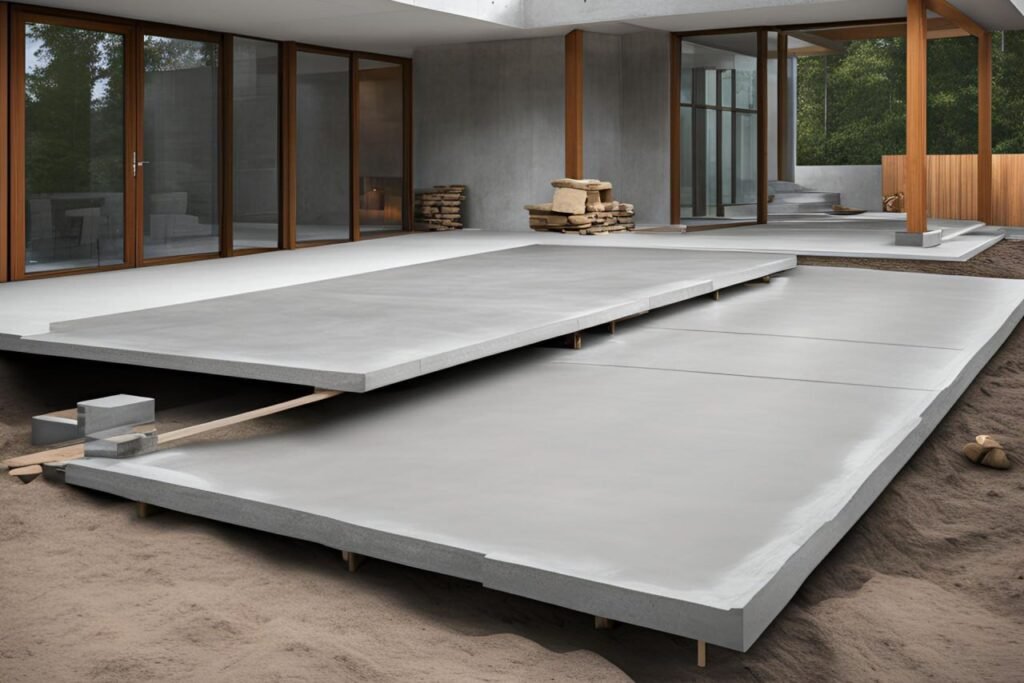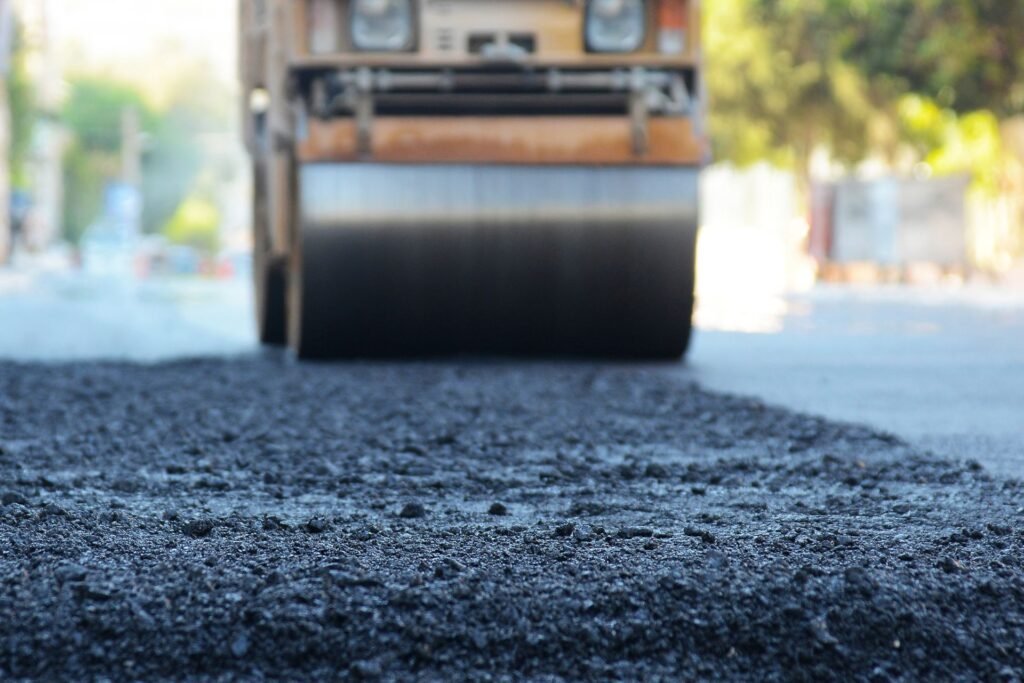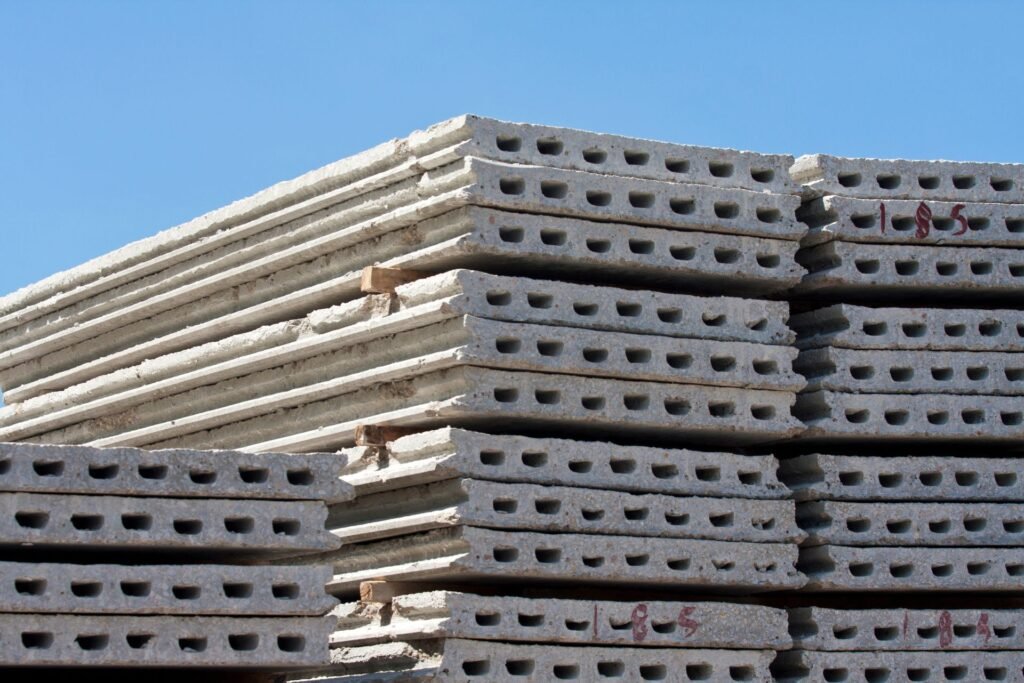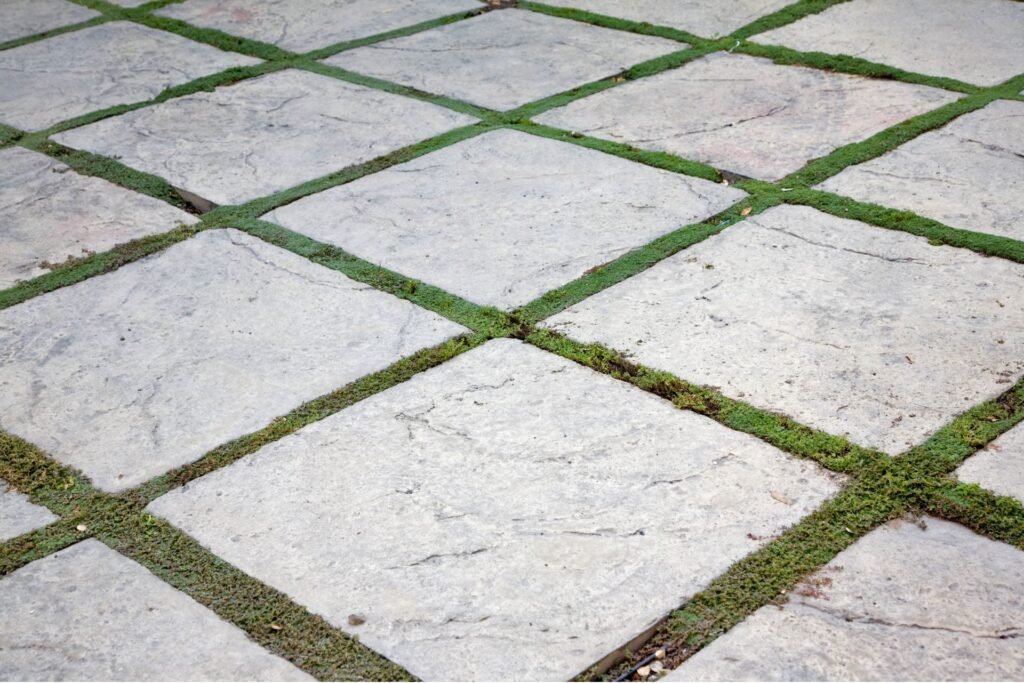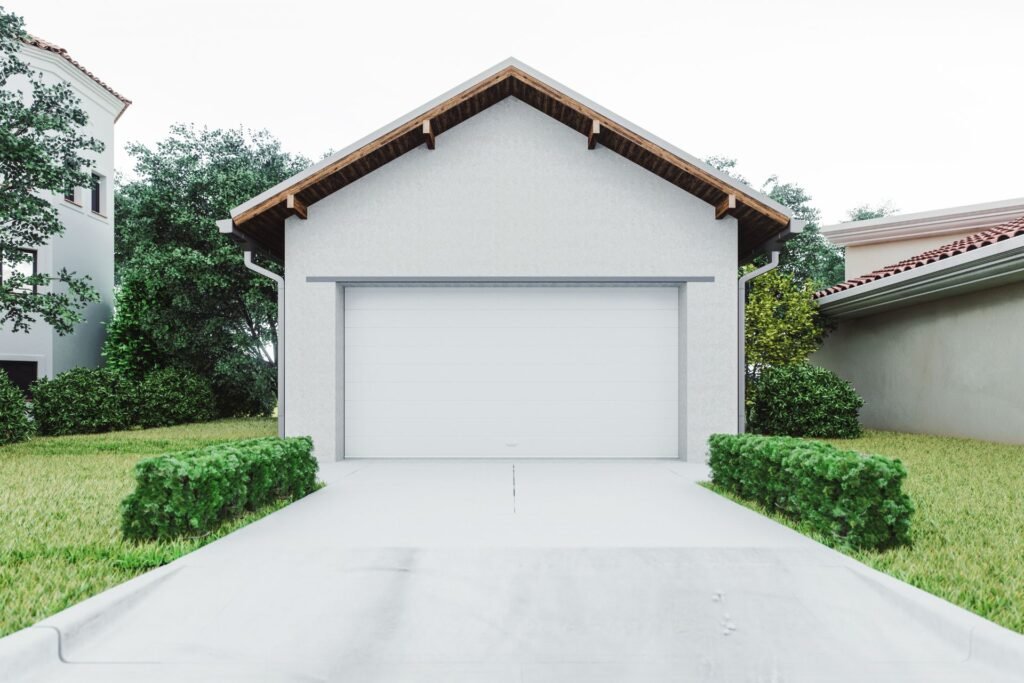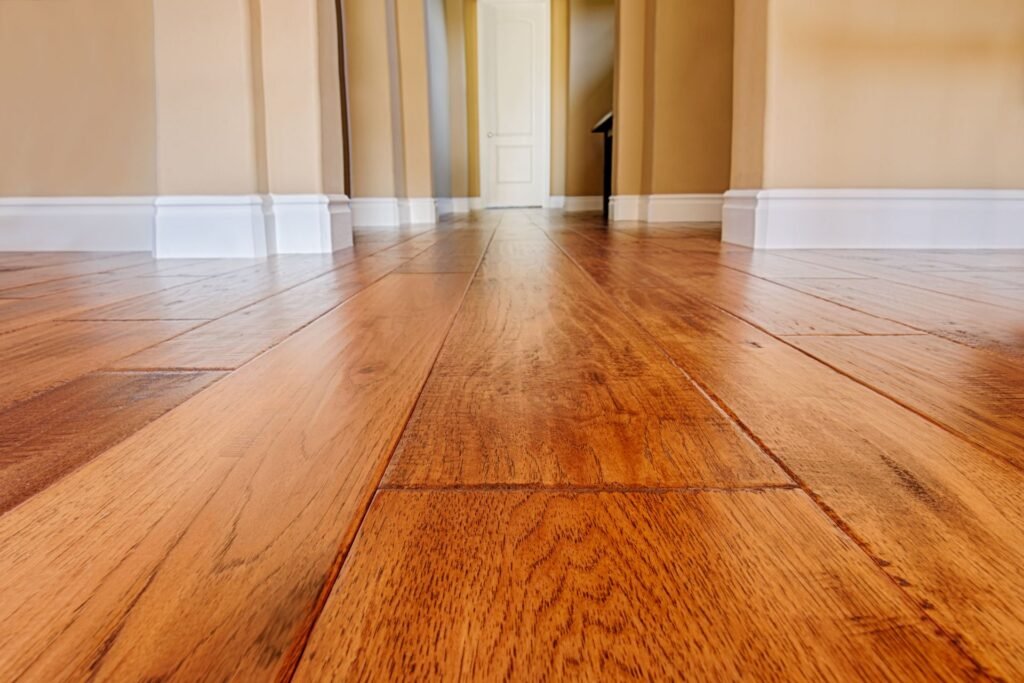Welcome to our comprehensive guide on the pros and cons of a concrete slab foundation. Choosing the right foundation for your home is crucial, and understanding the benefits and drawbacks of each option can help you make an informed decision. In this article, we’ll delve into what a concrete slab foundation is, explore its key advantages, and discuss potential downsides. Whether you’re planning a new build or considering renovations, this guide will provide you with the essential information needed to determine if a concrete slab foundation is the right choice for your home.
A concrete slab foundation is a type of building foundation made from a single, solid layer of concrete, typically 4-6 inches thick, poured directly onto the ground. Pros include cost-effectiveness, durability, pest protection, and energy efficiency. Cons involve potential for cracking and shifting, moisture issues, lack of access to utilities, and environmental impact. This foundation is ideal for warm climates with stable soil conditions and offers a low-maintenance option for homeowners.
Table of Contents
What Is A Concrete Slab Foundation
A concrete slab foundation is a flat, horizontal surface made of concrete, typically 4 to 6 inches thick, that serves as the base of a building. This type of foundation is constructed directly on the ground, providing a solid, stable platform for the structure above. The edges of the slab are often thicker to create a footing, which helps to distribute the weight of the building evenly and prevent shifting or settling over time. Concrete slab foundations are widely used in both residential and commercial construction due to their durability and ease of installation.
Construction Process
The construction of a concrete slab foundation involves several key steps. First, the site is prepared by clearing any vegetation and leveling the ground. A layer of gravel is then spread across the area to provide drainage and a stable base for the concrete. Next, formwork is installed to define the shape and size of the slab, and reinforcement materials such as steel rebar or mesh are placed within the formwork to add strength and prevent cracking.
Once the preparation is complete, the concrete is mixed and poured into the formwork. It is then spread evenly and smoothed out using specialized tools like a bull float. After the concrete has been poured, it must cure for several days to achieve its full strength. During this curing period, the surface is kept moist to prevent premature drying and cracking. Once fully cured, the formwork is removed, and the slab is ready for further construction.
Common Uses
Concrete slab foundations are commonly used in a variety of settings due to their versatility and cost-effectiveness. In residential construction, they are often chosen for single-family homes, particularly in regions with mild climates where the ground does not freeze deeply. This is because slab foundations can be constructed quickly and at a lower cost compared to other foundation types, such as basements or crawl spaces.
In commercial and industrial construction, concrete slab foundations are preferred for buildings like warehouses, factories, and retail stores. The strong, level surface provided by the slab is ideal for supporting heavy machinery and large equipment. Additionally, slab foundations are often used in the construction of garages, sheds, and outdoor structures, where a durable and low-maintenance base is required.
The widespread use of concrete slab foundations can be attributed to their strength, durability, and relatively low cost. They provide a reliable foundation for a wide range of building types and are a popular choice among builders and homeowners alike.

Pros Of A Concrete Slab Foundation
When considering the foundation for your home, it’s essential to weigh the benefits of different types. Concrete slab foundations offer several advantages that make them a popular choice for many homeowners. Let’s delve into the key benefits of opting for a concrete slab foundation.
Cost-Effective
- Initial Costs: One of the primary benefits of a concrete slab foundation is its cost-effectiveness. Compared to other foundation types, such as crawl spaces or basements, concrete slabs typically have lower initial costs. The construction process is straightforward and less labor-intensive, reducing both material and labor expenses. This makes concrete slabs an attractive option for budget-conscious homeowners or those looking to invest their money in other aspects of their home.
- Long-Term Savings: Beyond the initial cost savings, concrete slab foundations offer long-term financial benefits. These foundations are less prone to damage from moisture, pests, and shifting soil, which means you’ll likely spend less on maintenance and repairs over the years. The reduced need for upkeep translates into significant savings, allowing you to allocate funds to other home improvements or investments.
Durability and Strength
- Longevity: Concrete is renowned for its durability. A well-constructed concrete slab can last for decades without significant deterioration. Unlike wood, concrete does not rot, warp, or attract pests, ensuring a stable and enduring foundation for your home. This longevity provides peace of mind, knowing that the structural integrity of your home is secure.
- Load-Bearing Capacity: Concrete slabs have impressive load-bearing capacity, making them suitable for supporting heavy structures. Whether you’re building a single-story home or a multi-level property, a concrete slab foundation can handle the weight without compromising its integrity. This strength is particularly beneficial in areas prone to natural disasters, as it provides a solid base that can withstand substantial forces.
Pest Protection
- Barrier to Termites: One of the often-overlooked advantages of concrete slab foundations is their effectiveness in pest prevention. Termites, which can cause extensive damage to wooden structures, cannot penetrate concrete. This makes concrete slabs a formidable barrier against these destructive pests. By choosing a concrete slab foundation, you’re taking a proactive step in safeguarding your home from termite infestations and the costly repairs they necessitate.
Energy Efficiency
- Thermal Mass: Concrete has excellent thermal mass properties, meaning it can absorb and store heat. This characteristic helps maintain stable indoor temperatures by moderating temperature fluctuations. During the day, concrete slabs absorb heat from the sun, and at night, they slowly release this heat, keeping your home warmer in cooler periods and cooler during hot spells.
- Energy Savings: The thermal mass of concrete slabs contributes to energy savings. Homes with concrete slab foundations often experience reduced heating and cooling needs, leading to lower energy bills. By maintaining a more consistent indoor temperature, your HVAC system doesn’t have to work as hard, resulting in energy efficiency and cost savings over time.
Low Maintenance
- Minimal Upkeep: Concrete slab foundations are known for their low maintenance requirements. Unlike crawl spaces or basements, which may require regular inspections for moisture, pests, and structural issues, concrete slabs are relatively hassle-free. Routine checks are minimal, and there’s no need for extensive upkeep, making them a convenient choice for busy homeowners.
- Reduced Repair Needs: Thanks to their durability and resistance to common foundation problems, concrete slabs typically require fewer repairs than other foundation types. Issues such as rot, warping, and pest damage are virtually nonexistent with concrete, which means you’ll spend less time and money on repairs. This reliability ensures that your foundation remains in excellent condition for years to come.
Choosing a concrete slab foundation for your home offers numerous advantages, from cost savings and durability to pest protection and energy efficiency. These foundations provide a robust and reliable base that requires minimal maintenance, ensuring long-term benefits and peace of mind for homeowners. When planning your new home or renovation, consider the many pros of a concrete slab foundation as a smart and practical choice.
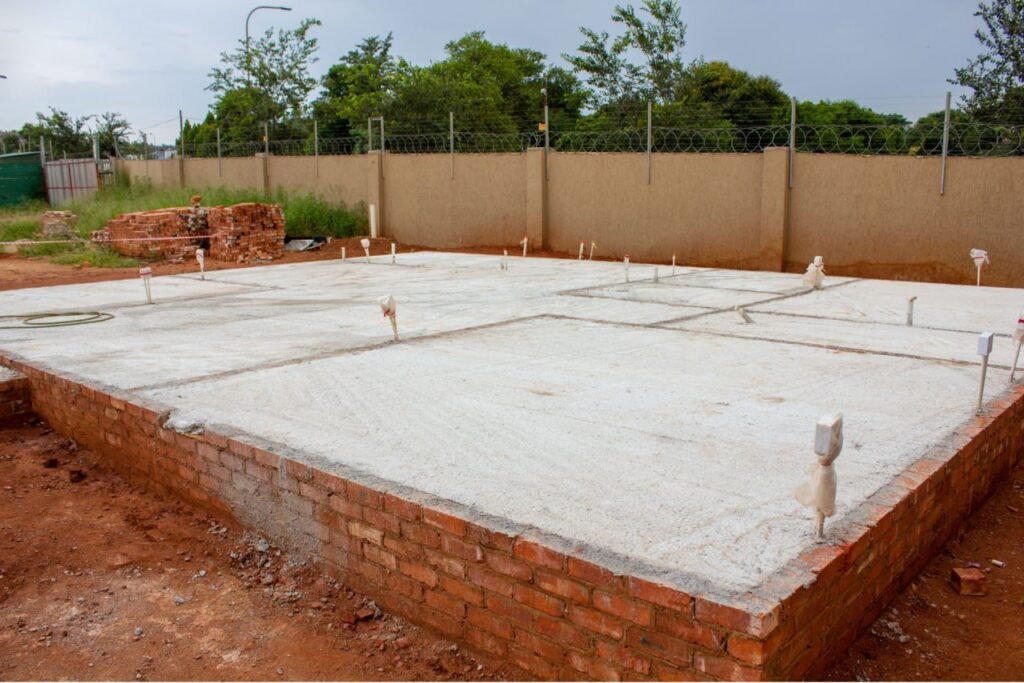
Cons Of A Concrete Slab Foundation
Concrete slab foundations offer several benefits, but they also come with a set of challenges and drawbacks. Understanding these cons can help homeowners make informed decisions about whether this type of foundation is the best choice for their needs.
Cracking and Shifting
- Settlement Issues: One of the primary concerns with concrete slab foundations is their tendency to crack and shift over time. As the soil underneath the slab settles, it can create uneven pressure points, leading to cracks. This is particularly common in areas with expansive clay soils that swell when wet and shrink when dry. Over time, these movements can cause significant damage to the foundation, impacting the overall stability of the structure.
- Repair Challenges: Repairing a cracked slab can be both difficult and costly. Unlike other types of foundations, where you can access the damaged areas more easily, concrete slabs require specialized techniques for repair. These might include injecting epoxy or polyurethane foam into the cracks or, in more severe cases, using hydraulic jacks to lift and level the foundation. These repairs can be disruptive and expensive, often requiring professional intervention.
Moisture Problems
- Water Intrusion: Concrete slabs are prone to moisture issues, particularly if they are not properly waterproofed. Water can seep through cracks or the porous surface of the concrete, leading to moisture accumulation beneath the slab. This can cause a range of problems, from weakening the foundation to creating a conducive environment for mold growth.
- Mold and Mildew: If moisture problems are not addressed, they can lead to the development of mold and mildew. These fungi thrive in damp environments and can cause health issues for the occupants, including respiratory problems and allergies. Additionally, mold can spread quickly, damaging not just the foundation but also the walls, floors, and other parts of the home.
Lack of Access
- No Crawl Space: Concrete slab foundations do not include a crawl space, which can be a significant drawback. Crawl spaces provide easy access to utilities like plumbing, electrical systems, and HVAC ducts. Without this access, performing maintenance or repairs on these systems becomes much more challenging.
- Difficult Repairs: When plumbing or electrical issues arise, repairing them can be a major hassle. Since these systems are often embedded in or run beneath the slab, accessing them typically requires cutting through the concrete, which is both labor-intensive and costly. This not only disrupts the living space but also compromises the integrity of the foundation.
Comfort and Aesthetics
- Cold Floors: Concrete floors can be uncomfortably cold, especially in regions with cooler climates. This can make the living space less comfortable for residents. While radiant heating systems can be installed to warm the floors, this solution can be expensive and might not always be feasible for every homeowner.
- Flooring Options: The nature of concrete limits the types of flooring that can be installed. While options like tile, vinyl, and certain types of carpet work well, other flooring materials such as hardwood might not be suitable without additional modifications. Homeowners looking for specific aesthetic choices might find these limitations frustrating.
Environmental Impact
- Carbon Footprint: The production of concrete has a significant environmental impact. It involves the extraction of raw materials like limestone and the emission of large amounts of CO2 during the manufacturing process. This contributes to the overall carbon footprint of construction projects, making concrete less environmentally friendly compared to other building materials.
- Sustainability Concerns: Beyond its carbon footprint, concrete raises other sustainability concerns. The extraction of raw materials can lead to habitat destruction and resource depletion. Additionally, the long-term durability of concrete is a double-edged sword; while it lasts a long time, it is not easily recyclable, contributing to landfill waste when buildings are demolished or renovated.
While concrete slab foundations offer durability and cost-effectiveness, they also present significant challenges in terms of maintenance, comfort, and environmental impact. Homeowners should weigh these cons carefully against the benefits when deciding on the best foundation type for their home.

Factors To Consider When Choosing A Foundation
Selecting the right foundation for a building is a critical decision that can significantly affect its durability and stability. Several factors come into play when making this choice. Let’s delve into the key considerations.
Climate
Temperature Extremes
The climate of an area plays a crucial role in determining the most suitable type of foundation. In regions with significant temperature fluctuations, concrete slab foundations can be affected by expansion and contraction, leading to cracks and structural damage. Areas with consistently mild temperatures might not face this issue, making concrete slabs a viable option. Conversely, extreme cold or heat necessitates special considerations, such as incorporating insulation or choosing materials that can withstand such conditions without deteriorating.
Moisture Levels
Local moisture levels are another vital climate-related factor. In areas with high humidity or frequent rainfall, the ground can become saturated with water, which affects the foundation’s integrity. Concrete slabs may be susceptible to shifting and cracking if the soil beneath them swells or shrinks with changing moisture levels. Therefore, it’s essential to ensure proper water drainage and consider moisture barriers to protect the foundation. On the other hand, dry climates might require measures to prevent soil dehydration, which can also lead to foundational instability.
Soil Type
Soil Stability
The type of soil on which the foundation will be laid significantly impacts its stability. Soils with high clay content can expand and contract dramatically with moisture changes, causing shifting and potential damage to the foundation. Sandy soils, while providing better drainage, may lack the necessary stability and require reinforcement. Before selecting a foundation type, conducting a thorough soil test is essential to understand its composition and stability. This information can guide the choice of foundation to ensure it can withstand the soil’s characteristics without compromising the building’s integrity.
Drainage
Proper drainage is crucial to maintaining a stable foundation. Poor drainage can lead to water accumulation around the foundation, increasing the risk of soil erosion and weakening the foundation’s support. Implementing effective drainage solutions, such as French drains or sloping the ground away from the building, helps manage water flow and prevent moisture-related issues. Ensuring that the foundation site has adequate drainage will prolong its lifespan and reduce the risk of structural problems.
Building Design
Structural Requirements
The design and weight of the building are pivotal in determining the appropriate foundation. A multi-story building or one with heavy materials like stone or brick requires a foundation that can support the additional load. Concrete slabs might be suitable for single-story buildings or those with lighter materials. However, larger or more complex structures often necessitate deeper foundations, such as pier and beam or piled foundations, to distribute the weight evenly and prevent settling.
Aesthetic Preferences
While structural integrity is paramount, aesthetic preferences can also influence foundation choices. The desire for certain architectural styles or finishes might dictate the type of foundation used. For example, homes with basements or crawl spaces allow for additional storage and living space, which might be a crucial consideration for some homeowners. On the other hand, a sleek, modern design might favor a concrete slab for its simplicity and clean lines. Balancing aesthetic desires with practical requirements ensures that the foundation not only supports the building effectively but also contributes to its overall appeal.
Choosing the right foundation involves a comprehensive assessment of various factors, including climate, soil type, and building design. By carefully considering these elements, you can select a foundation that provides stability, durability, and aligns with both structural needs and aesthetic preferences.

FAQs: About What Are The Pros And Cons Of A Concrete Slab Foundation
What is a concrete slab foundation?
A concrete slab foundation is a type of building foundation made from a single, solid layer of concrete, typically 4-6 inches thick, poured directly onto the ground. It is commonly used in residential and commercial construction for its simplicity and cost-effectiveness.
What are the main advantages of a concrete slab foundation?
The main advantages of a concrete slab foundation include cost-effectiveness, durability, pest protection, and energy efficiency. It offers long-term savings on maintenance and repairs, provides a strong and stable base for buildings, acts as a barrier to termites and other pests, and helps maintain stable indoor temperatures.
What are the potential downsides of a concrete slab foundation?
Potential downsides include the risk of cracking and shifting over time, moisture problems such as water seepage and mold, lack of access to utilities due to the absence of a crawl space, discomfort from cold floors, limitations in flooring options, and environmental impact due to the carbon footprint of concrete production.
How does climate affect the suitability of a concrete slab foundation?
Climate plays a significant role in the suitability of a concrete slab foundation. It is ideal for warm climates with stable soil conditions. In colder climates, measures need to be taken to prevent frost heave and ensure proper insulation to avoid cold floors.
What should I consider regarding soil type when choosing a concrete slab foundation?
When choosing a concrete slab foundation, it is important to consider soil stability and composition. Stable, well-draining soil is crucial to prevent settling and cracking. Poorly draining or expansive soils may require additional preparation and reinforcement to ensure the foundation’s longevity.
How do I address moisture problems in a concrete slab foundation?
To address moisture problems, ensure proper drainage around the foundation, use a vapor barrier during construction, and apply waterproof coatings or sealants to the concrete. Regular maintenance and inspection can also help detect and mitigate moisture issues early.
Can a concrete slab foundation be used in areas with high termite activity?
Yes, a concrete slab foundation can be used in areas with high termite activity. In fact, one of its advantages is that it acts as a barrier to termites, preventing them from accessing the wooden components of the building. However, additional termite control measures may still be necessary.
What are the maintenance requirements for a concrete slab foundation?
Maintenance requirements for a concrete slab foundation are relatively low. Regular inspections for cracks and moisture issues, sealing and waterproofing as needed, and ensuring proper drainage are key maintenance tasks. Addressing any minor issues promptly can prevent larger, more costly repairs.
How does a concrete slab foundation compare to other types of foundations in terms of cost?
A concrete slab foundation is generally more cost-effective than other types of foundations, such as crawl space or basement foundations. The initial construction costs are lower, and the long-term maintenance costs are also reduced due to the durability and low upkeep requirements of concrete.
Is a concrete slab foundation environmentally friendly?
While concrete production has a significant carbon footprint, a concrete slab foundation can still be considered relatively environmentally friendly due to its durability and longevity, which reduce the need for frequent repairs and replacements. Additionally, energy efficiency benefits can contribute to lower overall energy consumption in the building.
Conclusion
In conclusion, it’s important to weigh the pros and cons of different foundation types carefully. Concrete slabs offer durability and low maintenance but can be expensive and challenging to repair. Timber floors, on the other hand, are cost-effective and easier to work with but may not offer the same longevity. Based on these insights, a balanced recommendation would be to consider your specific needs, budget, and long-term plans. Consulting with a building professional or contractor is crucial in making an informed decision. They can provide tailored advice to ensure you choose the foundation that best suits your project requirements.
About the Author:
Mike Veail is a recognized digital marketing expert with over 6 years of experience in helping tradespeople and small businesses thrive online. A former quantity surveyor, Mike combines deep industry knowledge with hands-on expertise in SEO and Google Ads. His marketing strategies are tailored to the specific needs of the trades sector, helping businesses increase visibility and generate more leads through proven, ethical methods.
Mike has successfully partnered with numerous companies, establishing a track record of delivering measurable results. His work has been featured across various platforms that showcase his expertise in lead generation and online marketing for the trades sector.
Learn more about Mike's experience and services at https://theleadguy.online or follow him on social media:

